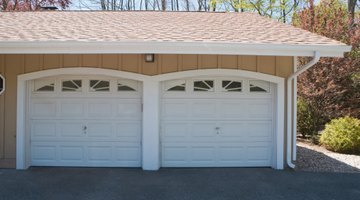How to Neutralize Salt on Concrete
In the winter months, salt used to de-ice roads and walkways makes its way on to your shoes, tires and vehicle undercarriage. While this layer of salt is important for melting ice and minimizing the hazards of driving in wintertime, the salt can wreak havoc on your concrete surfaces.

The salt will eventually eat through the concrete surfaces, such as walkways and garage floors, creating unattractive pits and a stained appearance. It is important to neutralize this salt on your concrete surfaces to prevent long term damage.
Things You Will Need
- Hose with high-pressure nozzle
- Hard-bristled scrub brush
-
Spray the concrete surfaces with warm water to neutralize and dissolve as much salt as possible. To prevent icing, wait for a warm, sunny day so the moisture will evaporate and not freeze on the concrete. If waiting for a warm day isn't practical, brush off as much of the liquid as possible after cleaning the cement. A thick, absorbent mop will also be effective in removing excess moisture. There are also cleaners for salt meant to be used in sub-zero temperatures.
-
Scrub the concrete thoroughly with a stiff brush to remove stubborn salt debris. Continue scrubbing and spraying the concrete surface until you're confident that the surface is clean.
-
Repeat this process as often as possible throughout the winter to prevent long term damage to your concrete floors and walkways.
Tip
For added cleaning strength, use a commercial cleaner such as Salt-Away, Salt-X or Euco Concrete Floor Cleaner. All three of these water soluble cleansers are effective at removing road salt from concrete surfaces. Make sure to follow the manufacturer's instructions so that you use the correct ratio of water to cleanser.
The Drip Cap
- In the winter months, salt used to de-ice roads and walkways makes its way on to your shoes, tires and vehicle undercarriage.
- Spray the concrete surfaces with warm water to neutralize and dissolve as much salt as possible.
- If waiting for a warm day isn't practical, brush off as much of the liquid as possible after cleaning the cement.
References
Writer Bio
Lynn Burbeck is a professional writer with over five years of experience writing for the Web. She has published numerous articles for print and online media including "Grit" Magazine. Burbeck holds a B.A. in journalism and political science.
Photo Credits
- Thinkstock Images/Comstock/Getty Images
- Thinkstock Images/Comstock/Getty Images
More Articles



